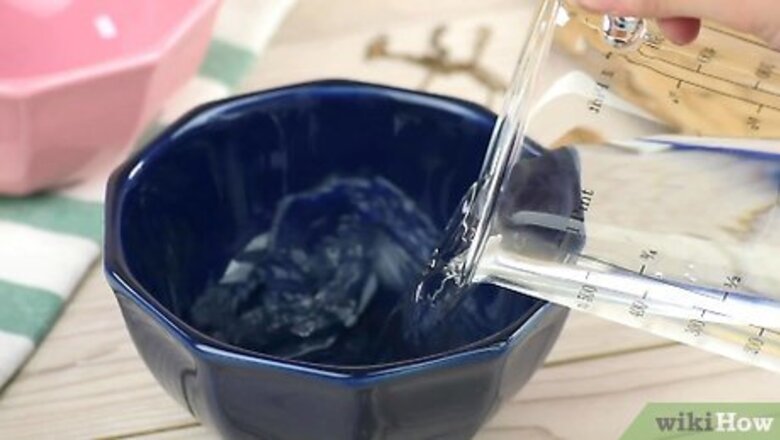
views
Cleaning with Vinegar
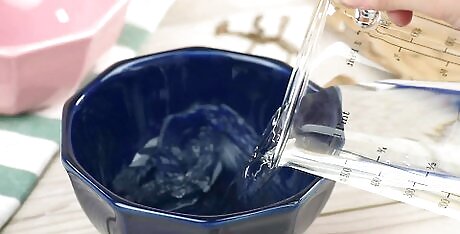
Fill a bowl with 1 c (240 mL) of white vinegar. White vinegar is a natural cleaning agent that is mildly acidic, but not so much that it will hurt your necklace. Pour some into a bowl or a shallow dish that is large enough to hold your necklace. You can find white vinegar at most home goods or grocery stores. Vinegar won’t harm costume jewelry, but it may hurt any precious metals or stones. Vinegar is great at removing rust, but won't work as well on tarnish.
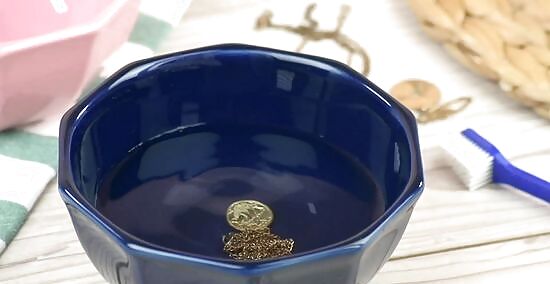
Submerge your necklace in the vinegar completely. Make sure all parts of your necklace are dunked underneath the vinegar, especially the areas with rust on them. If you need to, add more vinegar so that your necklace is entirely covered.

Let your necklace sit for about 8 hours. Vinegar takes time to loosen the rust attached to your necklace. Set your bowl in an area where it won’t be disturbed overnight and check on it in the morning.Warning: Don’t place the bowl directly in the sun, or it could heat up your vinegar.
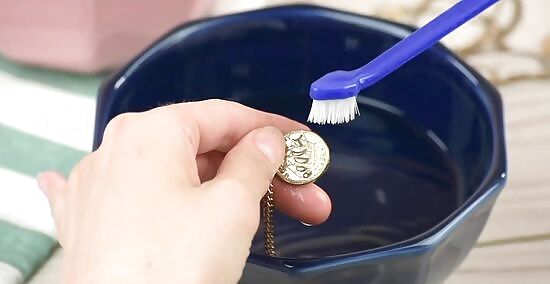
Scrub off the rust with a toothbrush. Pick your necklace out of the vinegar and set it down on a towel. Use a toothbrush to gently rub the rust off your necklace until it’s clean again. If there’s a lot of rust on your necklace, you can let it sit for another 1 to 2 hours to soak. A toothbrush has soft bristles that won’t scratch your necklace.
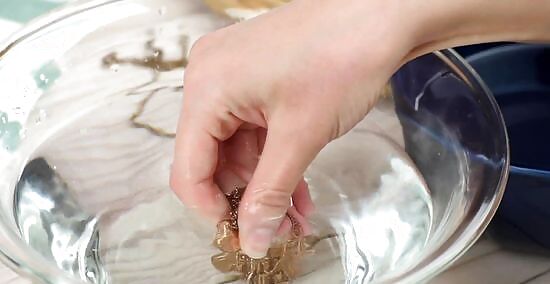
Rinse off your necklace with cool water. Make sure all of the vinegar is gone so that it doesn’t break down parts of your necklace. Focus the water on any areas that were especially rusty to clean them. Cool water is more gentle on your jewelry than warm water is.
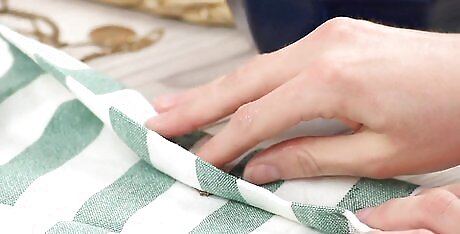
Pat your necklace dry with a clean cloth. Make sure your necklace is completely dry before you wear it or store it again. If your necklace is wet, it could get rusty again. Use a clean cloth so you don’t scratch your jewelry.
Using Dish Soap
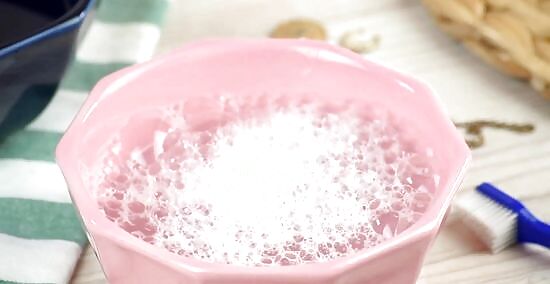
Mix 2 drops of dish soap with 1 cup (240 mL) of warm water. Use a small bowl to combine warm water from the sink with some mild dish soap. Try to use unscented, dye-free dish soap if you can to protect the surface of your necklace.Tip: Dish soap is gentle on jewelry and can’t cause a chemical reaction. It’s best for necklaces that aren’t super tarnished or ones that are metal-plated instead of fully metal.

Rub your necklace in the soap and water with your fingers. Dunk your necklace and chain into the water and make sure it’s fully submerged. Gently rub the surface of the pendant and the chain to get rid of any rust or tarnish. Using your fingers is more gentle than a cloth or a sponge, which can scratch delicate jewelry.
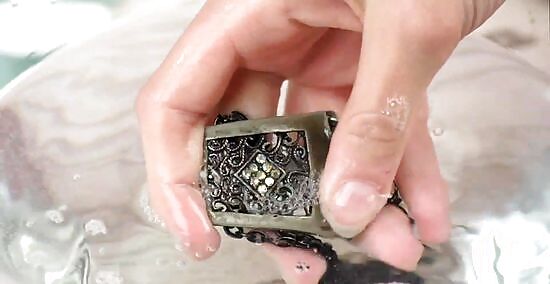
Rinse your necklace under warm water. Make sure there is no soap residue left on your necklace so that it doesn’t leave any dark spots. Use warm water to clean off any extra tarnished areas. Dry dish soap can discolor your necklace and make it look spotty.
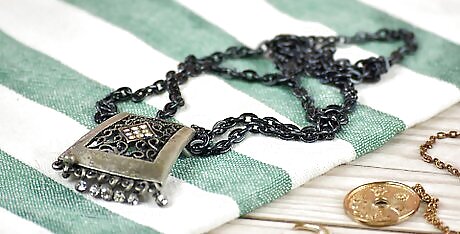
Pat your necklace dry with a clean cloth. Make sure your cloth is completely free from dirt and debris before you use it. Gently pat your necklace and make sure it is fully dry before you put it away. Storing your necklace while it’s wet can lead to more rust or tarnish. If your necklace is silver, buff some silver polish into its surface to keep it shiny.
Mixing Baking Soda and Salt
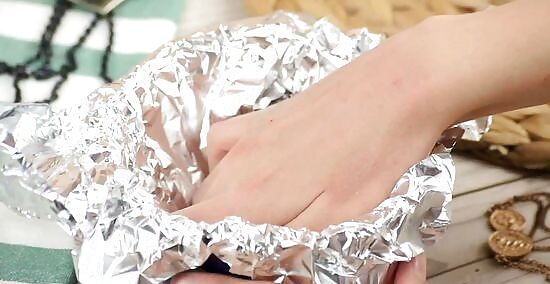
Line a small bowl with aluminum foil. Keep the shiny side of the foil up. Choose a bowl that can hold about 1 c (240 mL) of liquid. Aluminum foil creates an electrolytic reaction to remove tarnish and rust without harming the metal of the necklace.
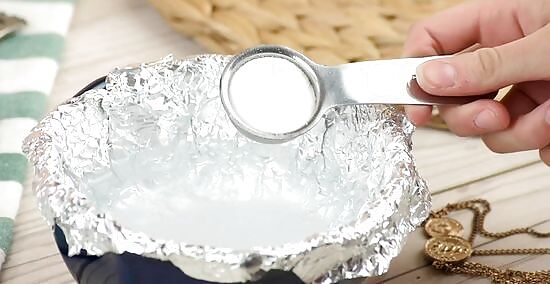
Mix 1 tbsp (14 g) of baking soda and 1 tbsp (14 g) of table salt with warm water. Heat up 1 c (240 mL) of warm water in the microwave until it is hot but not boiling. Pour the water in the bowl with the foil and then stir in the baking soda and table salt until they have dissolved completely. Baking soda is a natural cleaning agent that is mildly corrosive. It can remove tarnish from gold and silver, and rust from steel or costume jewelry.
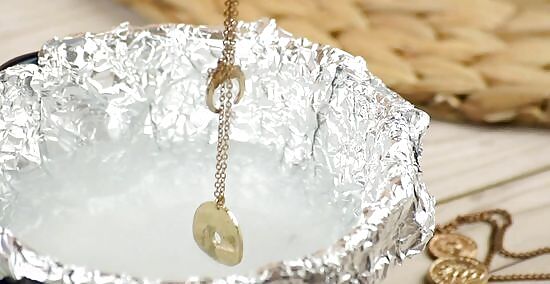
Submerge your necklace in the mixture and make sure it touches the foil. Use caution as you place your necklace in the bowl, since the water will still be hot. Make sure the necklace touches the bottom of the bowl so it’s in contact with the foil.
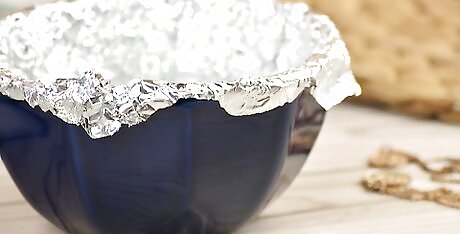
Let the necklace sit for 2 to 10 minutes. Depending on how tarnished or rusty your necklace is, you may need to let it sit for the full 10 minutes. You may notice some small bubbles on your necklace, which is just the chemical reaction removing the rust. If your necklace wasn’t super rusty, you can take it out after 2 or 3 minutes.

Rinse your necklace with cold water. Use tongs to pick your necklace out of the hot water and then clean it off in the sink with cool water. Make sure there is no residue of the salt or baking soda so they don’t sit on your necklace long term.Tip: Pour your baking soda and salt solution down the drain to discard of it.

Pat the necklace dry with a clean cloth. Set your necklace on a cloth laid flat and gently fold it over to pat the necklace dry. Leave the necklace out to air dry for 1 hour before you store it again to prevent rust, or put your necklace on right away to enjoy its new, shiny look. Rust builds up on necklaces when they are left in a moist or wet environment.












Comments
0 comment